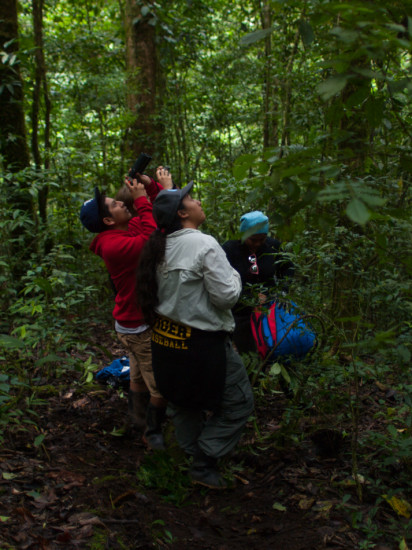Down Cerro Chai, some students spotted a dark-morph Crested Owl. Daniel (aka Bird) takes a photo through binoculars with his iPhone.

Down Cerro Chai, some students spotted a dark-morph Crested Owl. Daniel (aka Bird) takes a photo through binoculars with his iPhone.

Mel and José collected several similar looking, native species for their decomposition experiments. We chose leaves of Miconia appendiculata and an invasive bamboo (collecting leaves here) to compare in their experiments. Here, they collect the M. appendiculata leaves from trees lining the Río Java.
Under the guidance of Andy, a graduate of University of Akron and soon-to-be post-doc at University of Chicago, Alicia collects and investigates mayfly (Ephemoptera) communities within headwater streams at Las Cruces.
Cecropia is a genus of tropical tree that quickly grows in light gaps and often has some interesting relationships with symbiotic Azteca ants. There are presumibly three species in Costa Rica, and two of the species are the subject of study for several students here with NAPIRE. The third species (maybe) occurs at higher elevations, like at Las Alturas, and the group mentor, Cynthia Saugers, found several specimen. We also came across an extremely large, but recently deceased, specimen here. Most of the time, the diameter of these trees don’t get seem to get more than about 30 cm in diameter (at least from my glancing observations as an aquatic ecologist…).
A little lag, but here are some photos of the 4th of July dinner we had. This was on top of the station prepared dinner… so we got to eat dinner twice. Good stuff.
Mel, one of my students, is building a study investigating decomposition of leaves from a native tree Miconia appendiculata and an invasive bamboo Phyllostachys makinoi in streams. Here, she’s recruited some others to help her collect bamboo leaves.
Jason and I were a bit more successful at capturing the release of this large, nectivorous (?) bat.
Michael, an undergraduate researcher out of Stanford, is working at Las Cruces on animal decomposition. Briefly, he’s set out freshly-killed adult chickens and chicks in forests and agricultural lands (i.e., pasture and coffee plantation) and monitors what happens…
He’s got camera traps trained on the adult chickens, and uses transects through both habitat types to pair replicate locations with both major habitats. It’s interesting (and rather smelly) work: there are a number of specialist scavengers that feed on animal matter, and the roles animal detritus (feces + dead animal) play in communities is often overlooked in light of the overwhelming biomass that plants input into detrital pools in ecosystems. Michael has already found some exciting facilitation effects within the scavenger community.
Michael was kind enough to take me along on one of his sampling dates.